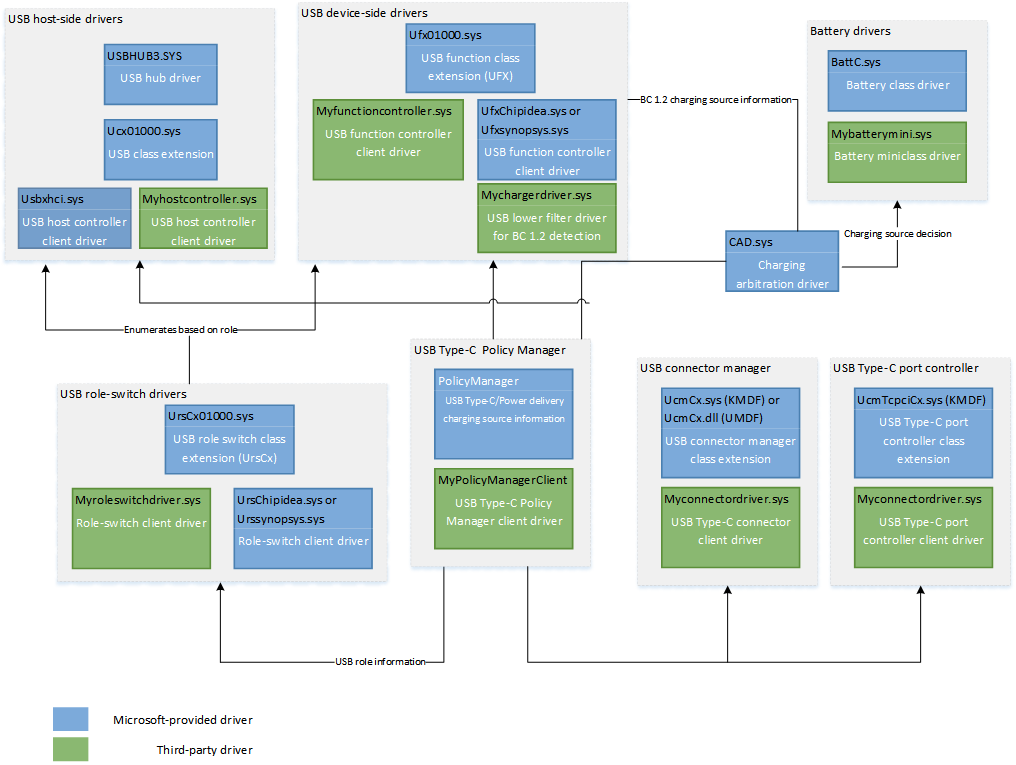Architecture: USB Type-C design for a Windows system
Describes a typical hardware design of a USB Type-C system and the Microsoft-provided drivers that support the hardware components. This article applies to OEMs developing systems with USB Type-C connectors.
- USB dual-role capabilities by using USB Type-C
- Faster charging by using USB Type-C current levels and Power Delivery 2.0
- Display-Out capabilities by using alternate modes and wired docking experiences.
Drivers for supporting USB Type-C components

In the preceding image,
USB device-side drivers
The USB device-side drivers service the function/device/peripheral. The USB function controller class extension supports MTP (Media Transfer Protocol) and charging using BC 1.2 chargers. Microsoft provides in-box client drivers for Synopsys USB 3.0 and ChipIdea USB 2.0 controllers. You can write a custom client driver for your function controller by using USB function controller client driver programming interfaces. For more information, see Developing Windows drivers for USB function controllers.
The SoC vendor might provide you with the USB function lower filter driver for legacy proprietary charger detection. You can implement your own filter driver if the function controller is Synopsys USB 3.0 or ChipIdea USB 2.0 controllers
USB host-side drivers
The USB host-side drivers are a set of drivers that work with EHCI or XHCI compliant USB host controllers. The drivers are loaded if the role-switch driver enumerates the host role. If your host controller is not specification-compliant, then you can write a custom driver by using USB host controller extension (UCX) programming interface. For information, see Developing Windows drivers for USB host controllers.
Note
Not all USB devices classes are supported on Windows 10 Mobile.
USB role-switch drivers (URS)
Systems can be designed such that the dual-role USB port needs Windows to configure it to either Host or Function mode. These designs will need to use the USB role switch (URS) driver stack.
The URS driver manages the current role of the connector, host or function, and the loading and unloading of the appropriate device side or host side drivers, based on hardware events from the platform. Microsoft provides in-box client drivers for Synopsys USB 3.0 and ChipIdea USB 2.0 controllers. You can write your role-switch client driver by using the USB dual-role controller driver programming interface. To activate the role-switch drivers, you must make changes to the ACPI tables. For more information, see USB Dual Role Driver Stack Architecture.
On systems with USB micro-AB connectors, this decision is made based on the ID pin in the connector. ID pin detection is performed by the client driver by using interrupt resources assigned to it.
On systems with USB Type-C connectors, the decision is made based on the CC pins. The client driver for connector performs CC detection and forwards that information to the role-switch driver.
USB connector manager (UCM)
This set of drivers manage all aspects of the USB Type-C connector. If your system implements a UCSI-compliant embedded controller over ACPI, use the Microsoft-provided UCSI driver. Otherwise write a UCSI client driver for non-ACPI transports.
If your hardware is not UCSI-compliant, then you are expected to write a USB Type-C connector driver that is a client to the UCM class extension. Together they manage a USB Type-C connector and the expected behavior of a connector driver.
If you are writing a driver, the USB connector manager class extension follows the WDF class extension-client driver model. Your client driver communicates with the hardware and the class extension to handle tasks such as CC detection, PD messaging, Muxing, and VBus/VConn control, and select policy for power delivery and alternate mode. The class extension communicates the information reported by the client driver to the operating system. For example, the CC detection result is used to configure the role-switch drivers; USB Type-C/PD power information is used to determine the level at which the system should charge. The client driver manages USB Type-C and PD state machines. The client driver can delegate some tasks to other drivers, for example, Mux may be controlled by another driver. To write the client driver, use the USB Type-C connector driver programming interfaces.
USB Type-C port controller
The Type-C Port Controller Interface Class Extension (UcmTcpciCx.sys) is an extension to the USB Connector Manager provided by Microsoft that allows the OS to behave as a Type-C Port Manager (TCPM) for a connector that does not implement the PD state machines. A UcmTcpciCx client driver allows the software TCPM to control the hardware and get its status in real time.
For information about writing the client driver, see Write a USB Type-C port controller driver.
Charging arbitration driver
This driver is provided by Microsoft for Windows 10 Mobile. The driver acts as the arbiter for multiple charging sources. The USB connector manager reports USB Type-C and PD charging source information to CAD, which makes a selection from that information and BC1.2 charger detection performed by the USB device-side drivers (if applicable). CAD then reports the most appropriate charging source to use to the battery subsystem.
Battery drivers
The class driver defines the overall functionality of the batteries in the system and interacts with the power manager. The miniclass driver handles device-specific functions such as adding and removing a battery, and keeping track of its capacity and charge. The miniclass driver exports routines that the class driver calls to get information about the devices it controls.